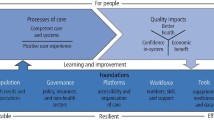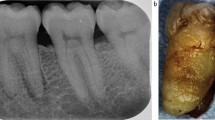Key Points
-
The greater use of skill mix in dentistry continues to lag behind medicine, where its use in both primary and secondary care environments is widespread.
-
Previous research has demonstrated that financial constraints are a problem to the wider use of skill mix in dental practices.
-
This paper assesses the financial incentives for utilising skill mix in general dental practice under the current National Health Service contract.
Abstract
The use of skill mix in medicine is now widespread, yet it appears that its use in dentistry is not as prominent. Unlike doctors, dentists are required to mitigate the financial risk produced by their capital investment and ensure an adequate cash flow to cover their annual running costs. Examining the financial incentives for employing dental care professionals is therefore an important step to understand why dentistry appears to lag behind medicine in skill mix. It is also apposite, given the announcement of the coalition government to develop a new contract, which could introduce incentives for the use of dental care professionals in this way. The purpose of this short paper is to examine whether skill mix is profitable for general dental practices under the existing NHS contract in England.
Similar content being viewed by others
Log in or create a free account to read this content
Gain free access to this article, as well as selected content from this journal and more on nature.com
or
References
Shaw D, Macpherson L, Conway D . Tackling socially determined dental inequalities: ethical aspects of Childsmile, the national child oral health demonstration programme in Scotland. Bioethics 2009; 23: 131–139.
Godson J H, Williams S A . Inequalities in health and oral health in the UK. Dent Update 2008; 35: 243–250.
Office for National Statistics. Adult dental health survey: oral health in the United Kingdom 1998. London: Office for National Statistics, 1998. http://www.statistics.gov.uk/pdfdir/dh0999.pdf.
Office for National Statistics. Children's dental health in the United Kingdom 2003. London: Office for National Statistics, 2003.
NHS National Workforce Projects. Dental workforce resource pack. Manchester: NHS National Workforce Projects, 2005.
Gallagher J E, Wilson N H . The future dental workforce? Br Dent J 2009; 206: 195–200.
Department of Health. NHS dentistry: options for change. London: The Stationery Office, 2002.
National Institute for Health Research. The impact of incentives on the behaviour and performance of primary care professionals. London: The Stationery Office, 2010. http://www.sdo.nihr.ac.uk/files/project/158-exec-summary.pdf.
Milsom K M, Jones C, Kearney-Mitchell P, Tickle M . A comparative needs assessment of the dental health of adults attending dental access centres and general dental practices in Halton & St Helens and Warrington PCTs 2007. Br Dent J 2009; 206: 257–261.
Hart J T. The inverse care law. Lancet 1971; 1: 405–412.
Department of Health. Implementing the Next Stage Review visions: the quality and productivity challenge. London: Department of Health, 2009. http://www.dh.gov.uk/en/Publicationsandstatistics/Lettersandcirculars/Dearcolleagueletters/DH_104239.
Steele J. Review of NHS dental services in England. London: Department of Health, 2009.
McGlashan G, Watson D J, Shanks S . Professionals complementary to dentistry: the expanding role of PCDs. Dent Update 2004; 31: 529–532.
Drinkwater C. Local commissioning: opportunity or threat? London: British Dental Association, 2009.
Laurant M, Reeves D, Hermens R, Braspenning J, Grol R, Sibbald B . Substitution of doctors by nurses in primary care. Cochrane Database Syst Rev 2005; 2: CD001271.
Richardson G, Maynard A, Cullum N, Kindig D . Skill mix changes: substitution or service development? Health Policy 1998; 45: 119–132.
Imperial Cancer Research Fund OXCHECK Study Group. Effectiveness of health checks conducted by nurses in primary care: final results of the OXCHECK study. BMJ 1995; 310: 1099–1104.
Aubert R E, Herman W H, Waters J et al. Nurse case management to improve glycemic control in diabetic patients in a health maintenance organization. A randomized, controlled trial. Ann Intern Med 1998; 129: 605–612.
Horrocks S, Anderson E, Salisbury C . Systematic review of whether nurse practitioners working in primary care can provide equivalent care to doctors. BMJ 2002; 324: 819–823.
Brown S A, Grimes D E . A meta-analysis of nurse practitioners and nurse midwives in primary care. Nurs Res 1995; 44: 332–339.
Wright J, Williams R, Wilkinson J R . Development and importance of health needs assessment. BMJ 1998; 316: 1310–1313.
Nutbeam D. Health literacy as a public health goal: a challenge for contemporary health education and communication strategies into the 21st century. Health Promot Int 2000; 15: 259–267.
Woolgrove J, Boyles J . Operating dental auxiliaries in the United Kingdom – a review. Community Dent Health 1984; 1: 93–99.
General Dental Council. Scope of practice consultation. London: General Dental Council, 2008. http://www.gdc-uk.org/NR/rdonlyres/CEADC21D-53B5-4B00-99EC-AB69F46585D4/75351/ScopeofPracticeconsultation2008.pdf
Williams S A, Bradley S, Godson J H, Csikar J I, Rowbotham J S . Dental therapy in the United Kingdom: part 3. Financial aspects of current working practices. Br Dent J 2009; 207: 477–483.
Harris R, Burnside G . The role of dental therapists working in four PDS pilots: type of patients seen, work undertaken and cost-effectiveness within the context of the dental practice. Br Dent J 2004; 197: 491–496.
Ward P. The changing skill mix – experiences on the introduction of the dental therapist into general dental practice. Br Dent J 2006; 200: 193–197.
Dyer T A, Humphris G, Robinson P G . Public awareness and social acceptability of dental therapists. Br Dent J 2010; 208: E2.
Sun N, Burnside G, Harris R . Patient satisfaction with care by dental therapists. Br Dent J 2010; 208: E9.
Rowbotham J S, Godson J H, Williams S A, Csikar J I, Bradley S . Dental therapy in the United Kingdom: part 1. Developments in therapists' training and role. Br Dent J 2009; 207: 355–359.
McKendrick A J. The economics of caries prevention by dental hygienists. Public Health 1971; 85: 219–227.
Godson J H, Williams S A, Csikar J I, Bradley S, Rowbotham J S . Dental therapy in the United Kingdom: part 2. A survey of reported working practices. Br Dent J 2009; 207: 417–423.
NHS Primary Care Commissioning. The use of fluoride varnish by dental nurses to control caries. London: Department of Health, 2009.
Milsom K M, Blinkhorn A S, Tickle M . The incidence of dental caries in the primary molar teeth of young children receiving National Health Service funded dental care in practices in the North West of England. Br Dent J 2008; 205: E14.
Marinho V C C, Higgins J P T, Logan S, Sheiham A . Fluoride varnishes for preventing dental caries in children and adolescents. Cochrane Database Syst Rev 2002; 2: CD002279.
Department of Health, British Association for the Study of Community Dentistry. Delivering better oral health: an evidence-based toolkit for prevention – second edition. London: The Stationery Office, 2009.
Birch S. The identification of supplier-inducement in a fixed price system of health care provision. The case of dentistry in the united kingdom. J Health Econ 1988; 7: 129–150.
National Audit Office. Maintaining financial stability across the United Kingdom's banking system. London: The Stationery Office, 2009.
HM Government. The Coalition: our programme for government. London: Cabinet Office, 2010.
NHS Business Service. NHS Dental Services login page. Available at: https://www.eservice.dpb.nhs.uk/apps/welcome.html. Accessed 18 March 2011.
NHS Information Centre. NHS Dental Statistics for England: 2008/09. Available at: http://www.ic.nhs.uk/statistics-and-data-collections/primary-care/dentistry/nhs-dental-statistics-for-england:-2008-09. Accessed 18 March 2011.
Author information
Authors and Affiliations
Corresponding author
Additional information
Refereed paper
Rights and permissions
About this article
Cite this article
Brocklehurst, P., Tickle, M. Is skill mix profitable in the current NHS dental contract in England?. Br Dent J 210, 303–308 (2011). https://doi.org/10.1038/sj.bdj.2011.238
Accepted:
Published:
Issue date:
DOI: https://doi.org/10.1038/sj.bdj.2011.238
This article is cited by
-
Timings and skill mix in primary dental care: a pilot study
British Dental Journal (2019)
-
General dental practices with and without a dental therapist: a survey of appointment activities and patient satisfaction with their care
British Dental Journal (2018)
-
Clinical leadership and prevention in practice: is a needs led preventive approach to the delivery of care to improve quality, outcomes and value in primary dental care practice a realistic concept?
BMC Oral Health (2015)
-
Alternative scenarios: harnessing mid-level providers and evidence-based practice in primary dental care in England through operational research
Human Resources for Health (2015)
-
Systematic review of patient safety interventions in dentistry
BMC Oral Health (2015)



